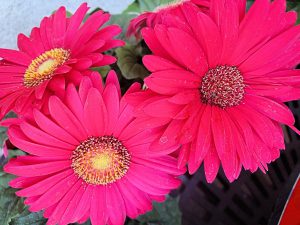
What perennial comes from Transvaal, South Africa, in yellow, orange, pink, and red with single, double or crested flowers and does well in Florida? Gerberas or Transvaal daisies is the correct answer! I saw some wonderful specimens at a garden center the other day and thought what a unique plant this is to brighten up the landscape, make a stunning potted plant, or serve as an excellent cut flower.
Selection of gerbera varieties depends on your own desires. Keep in mind that most gerberas on the market are single petalled – simple design, but still glorious. Whether single, double or crested, keep in mind that hybrids are available with long-lasting flowers that remain open even in the dark. These perennials like full sun but will tolerate some shade. Purchasing small, started plants is a good way to begin. Prepare your planting site with organic matter and plant the seedlings about twelve to eighteen inches apart. You should expect blooms in about seven to ten weeks. If your planting site is in an excessively moist spot, consider planting on raised mounds or beds. Gerberas may become root disease-prone if they are kept too moist – good drainage is essential.
Large specimen plants are also available, and though more expensive, are already blooming and can make an instant impact on your landscape. Since they are already flowering you more easily make selections of colors and flower types. These larger plants also allow you to keep them as container plants for decoration around patios, swimming pools and driveways. Plants that are one year old or older with multiple crowns can be dug and divided. Clean off old dead roots and leaves and cut off one-half of mature leaves before setting back in the planting bed.
Starting gerberas from seeds is the least expensive way to obtain these plants. Use a sterile medium to start seeds planting them about two times the diameter of the seed in flats or pots. Keep the soil moist and transplant into small pots as soon as you notice the first true leaves. Transplant out into the garden as soon as they are large enough.
While mulch may be beneficial to help retain moisture and keep out weeds, keep in mind that gerbera crowns will eventually grow downward and “sink” into the soil as they grow. This sunken crown will subject the plant to possible rots and thus should be dug and replanted after about two years. A slow-release fertilizer which contains iron and manganese is a good strategy to supply these often-deficient micronutrients.
While gerberas can suffer from spider mites, leaf miners, thrips and caterpillars, the biggest problem I have seen is powdery mildew. Too much shade and overcrowding can sometimes provide the environment for this fungal disease to develop.
Gerberas, members of the sunflower family, are a bright delight that should be part of your flower garden. Try some, and if you need more information about their culture, you can also call the Master Gardener Volunteer Helpdesk on Mondays, Wednesdays and Fridays from 1 to 4 pm at 764-4340 for gardening help and insight into their role as an Extension volunteer. Ralph E. Mitchell is the Director/Horticulture Agent for UF/IFAS Extension – Charlotte County. He can be reached at 941-764-4344 or ralph.mitchell@charlottecountyfl.gov . Connect with us on social media. Like us on Facebook @CharlotteCountyExtension and follow us on Instagram @ifascharco.
Resource:
Brown, S. P., Deng, Z., Tjia, B. & Black R. J. (2017) Gerberas at a Glance. University of Florida Extension Service, IFAS.
 3
3
